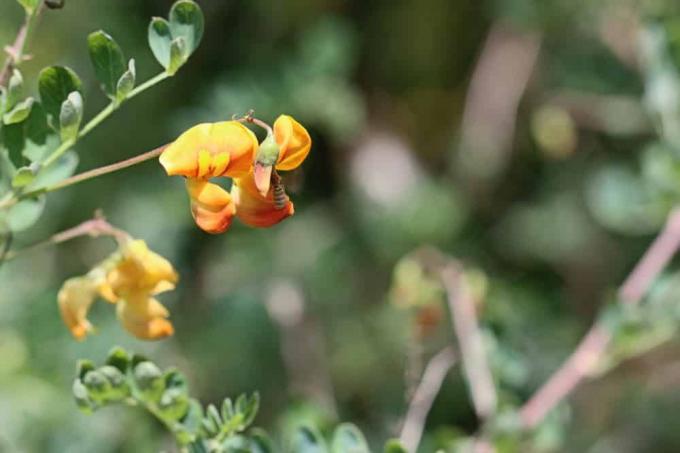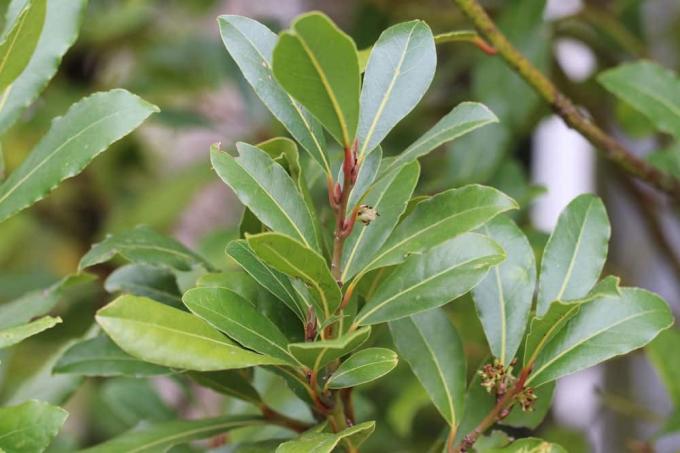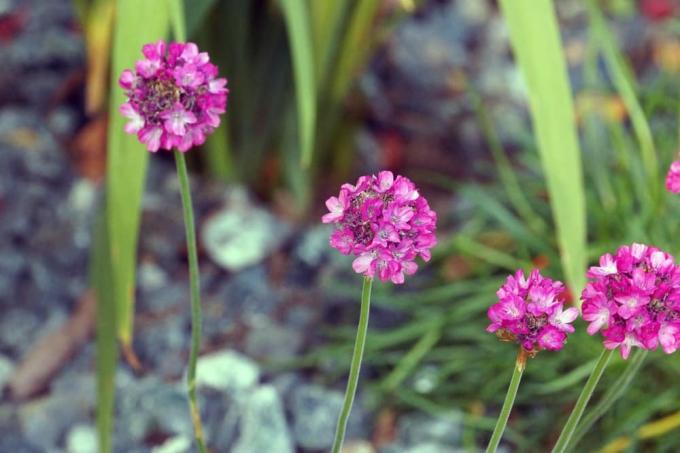

Table of contents
- Location
- soil condition
- watering and fertilizing
- Cut
- multiply
- sowing
- cuttings
- origin and description
- toxicity of the plant
- Conclusion
In the natural garden, the yellow bladder bush impressively demonstrates how ecology and aesthetics go hand in hand. With a lavish bloom of bright yellow followed by decorative legumes in fall, the ornamental tree delights insects, birds and gardeners alike. The Colutea arborescens is so frugal that it thrives as a pioneer tree even under poor conditions. The only downer is the poison content of its leaves and seeds. The following lines explain how to properly care for the yellow bladder bush.
Location
In creative garden design, a yellow bladder bush takes on a variety of tasks. So it blends harmoniously into a mixed hedge, thanks to its sociability. In addition, it is there when a steep embankment needs to be paved. Due to its deep-reaching taproots, nothing will slip here so quickly. Its graceful silhouette also qualifies the Colutea arborescens as a magnificent solitaire that draws everyone's attention. If the site conditions then meet its low demands, the ornamental shrub will meet all the expectations placed in it.
- Sunny position to light penumbra
- Stagnant summer heat is tolerated
- Light wind exposure is acceptable
Native to southern Europe, the bladder bush also favors warm garden areas without a cold draft in the local regions. This preference does not detract from its winter hardiness, as it has shed its foliage at this time of year.
soil condition
If you give the ornamental tree a place in full sun, it will feel extremely at home there if the soil is as follows:
- Sandy, dry and with some clay
- Poor in nutrients and humic
- Of high permeability
- A pH greater than 7 is ideal
The yellow bladderbush will not develop its beauty in a permanently damp or even acidic soil. Especially in compacted soil, its taproots do not penetrate and the tree dies.
watering and fertilizing
In order to properly care for a yellow bladder bush, extreme restraint is required with regard to the water and nutrient balance. A well-established shrub is content with the natural rainfall. During periods of summer drought, it should still be watered so that the plant does not suffer from drought stress. A fixed fertilization plan is not necessary. If you are already out in the garden with a wheelbarrow of compost, the Colutea arborescens will be happy to receive a portion. In August, the application of nutrients ends so that the bush can mature before winter. If there is an oversupply of nutrients in late summer, more branches will sprout, and their soft tissue will freeze back with the first frost. This process weakens the shrub as a whole, making it susceptible to disease and pests.
Tip:
A start fertilization in March/April in the form of compost, cattle manure and horn shavings promotes the vitality of a yellow bladder bush.
Cut
Thanks to its uncomplicated care, the bladder bush is often settled in public parks and facilities. Here, its visual appearance suffers considerably within a few years because a central aspect is not taken into account. The ornamental tree only develops an attractive stature if it is allowed to be cut back once a year. Otherwise it will spread in all directions, continue to lignify and bare from the inside out. As a result, the beautiful labial flowers only thrive lonely and sporadically at the tips of the branches. Such a fate will not befall the Colutea arborescens in a well-kept hobby garden, because here it is cut in early spring. Pruning the summer bloomer immediately after flowering is a major disadvantage for two reasons: A late pruning causes autumn shoots that will freeze in winter. The magnificent legumes should not be removed, as they also adorn the shrub during the cold season. How to professionally prune a yellow bladder bush:
- The weather is frost-free, dry and overcast
- The cutting tool is freshly ground and disinfected
- Gloves protect against contact with the toxic content
- Cut old, dead branches at the base
- Cut off branches pointing inward and crossing branches
- Thin out enough to allow light and air to reach all areas
- Shorten shoots that are too long by a maximum of one third
The rule of thumb for a spring pruning is that a strong pruning causes an intensive budding and vice versa. As part of the proper cutting process, the only thing to note is that the scissors are always set 2-3 mm above a bud. A slight incline ensures that plant sap and rainwater can run off better. This prudence prevents a fungal infection.
Tip:
Yellow bladderbush clippings are toxic to horses and should never be disposed of in a pasture.
multiply
If successful care has awakened the desire for more specimens of Colutea arborescens, you have the choice of two methods of propagation:
sowing
If the poison content of the seeds does not deter you, collect them from the legumes in autumn or buy the seeds from specialist shops. The best time for sowing is early spring. Here's how to do it:
- Fill small pots with seed soil, perlite or peat sand
- Plant 1-2 seeds about 1 cm deep in each one
- Moisten with water from the spray bottle without soaking the substrate
- Expect germination at a partially shaded window seat at 20-25 degrees Celsius

Within 1-3 weeks, the first leaves develop, which are quickly followed by others. Keep the substrate slightly moist. If several plants thrive in the seed pot, the weaker seedlings should be sorted out from a growth height of 5 cm. Once the young plants have fully rooted in the pot, they are planted out in the bed.
cuttings
A good time for propagating cuttings is early summer. Semi-lignified shoots with a length of 10-15 cm are ideal. This is how the offshoots turn into young bladder bushes:
- Defoliate the lower half of each cutting
- Fill small pots with lean pricking soil or standard soil (TKS1)
- Insert an offshoot with the defoliated part in each
- Moisten the substrate and put a plastic bag over it
Placed in a semi-shady, warm place, each cutting develops its own root system. During this phase, the soil must not dry out. A fresh shoot signals the successful course of propagation. The plastic bag is no longer necessary. The young plant now welcomes a few hours of sunshine a day. When the growing pot is fully rooted, the bladder bush is repotted in a mixture of one third of standard soil, perlite and sand. Throughout the winter, take care of it properly in a light or dark place at temperatures of 0-5 degrees Celsius. A sip of water every now and then keeps the soil from drying out. Plant a vigorous, robust Colutea arborescens in the bed next spring.
origin and description
The bladder bush is native to the Mediterranean and North Africa, but can also be found in the wild in this country. It grows up to five meters high and blooms with golden yellow flowers from May to the end of summer. After pollination, the flowers develop into legumes with seeds that can grow up to eight centimeters long. They are initially green, later turning slightly reddish and then becoming parchment-like.
These pods contain carbon dioxide and therefore look puffed up, giving this plant its name. They often stay on the bush all winter long, so that a beautiful decoration in the garden is also provided during this time. In strong winds, the pods are torn from the bush and carried to other locations, causing this plant to spread further. Otherwise, the pods will dry up over time and then release their seeds. Because the bladder bush has a long flowering period, flowers and fruits can often be seen on the bush at the same time.
toxicity of the plant
Bladder bush is one of the poisonous plants and can cause problems for humans and animals. Its leaves and seeds contain mild toxins that cause nausea, vomiting, and diarrhea when consumed. For households with small children or pets, the bladder bush is therefore only partially suitable as an ornamental plant for the garden. However, due to the unpleasant odor and bitter taste of the seeds, children are only slightly endangered in this regard.
The leaves and seeds were once used in natural medicine to treat constipation for their laxative properties, but are no longer used today.
Conclusion
The yellow bladder bush provides convincing proof that closeness to nature and a sense of horticultural beauty do not have to be mutually exclusive. As early as spring, the wood unfolds its bright yellow blossoms, over which bumblebees, bees and butterflies cheer well into August. This is followed by the conspicuous legumes that provide food for the birds during the cold season. All these ecological advantages go hand in hand with a magnificent appearance both as a solitary plant and in a hedge. In return, a Colutea arborescens only expects a sunny, sandy, dry location and a little water when it is dry. In order to properly care for it, the focus is primarily on an annual pruning. This measure keeps the ornamental tree in shape and always attracts the enchanting splendor of flowers.
 garden editorial
garden editorial I write about everything that interests me in my garden.
Learn more about garden plants - care

Lepidoptera, Faboideae - characteristics and representatives from A-Z
From the tropics to the arctic, legumes colonize our planet with more than 12,000 species. They serve us as ornamental and food plants or annoy us as weeds. Immerse yourself in the fascinating world of butterfly blossom plants. Get to know their characteristics and meet their representatives from A-Z.

Laurel tree has brown leaves - diseases + pests on laurel
If the spice laurel suddenly gets yellow leaves, which then turn brown and possibly fall off, the cause of the disease must be found out. This is the only way to do something against the dying of the laurel tree. In many cases, the plant can be saved quite easily.

Double garden jasmine, chanterelle tree - care, cutting and propagation
A concentrated, delicate white blossom and an enchanting scent characterize the double garden jasmine, which is also known under the name mock orange. It is therefore becoming increasingly popular in local gardens as hedges and privacy screens or as a solitaire. The ornamental tree is very easy to care for and should therefore not be missing in any garden.

Laurel tree, Laurus nobilis - information on care, propagation and wintering
The laurel tree is a popular, evergreen shrub that is suitable for pot culture or also grows in mild locations in the garden. Cared for and neatly cut, the dark green, leathery foliage can provide breathtaking accents in entrance areas or on terraces. You can find out how to properly care for the laurel here.

Thrift, Armeria - Varieties, care and information on winter hardiness/toxicity
Its long flowering period and uncomplicated care make the thrift a popular perennial that knows how to make a brilliant understatement. Where other summer flowers languish in the dry, sunny location, armeria trumps with colorful flowers. Explore the most beautiful varieties, practical care instructions and well-founded information on winter hardiness and toxicity.

Catchfly, Silene viscaria - sowing, planting & care
The pitcher (Lychnis viscaria) is a perennial, bushy wild perennial belonging to the Carophyllaceae family. Since it originally comes from the Mediterranean region, it is suitable for moor gardens, for green roofs, as a hardy garden perennial and as a decorative cut flower. The plant usually flowers from May to August in a strong fire or chimney red and reaches a height of about 40 to 50 cm.



